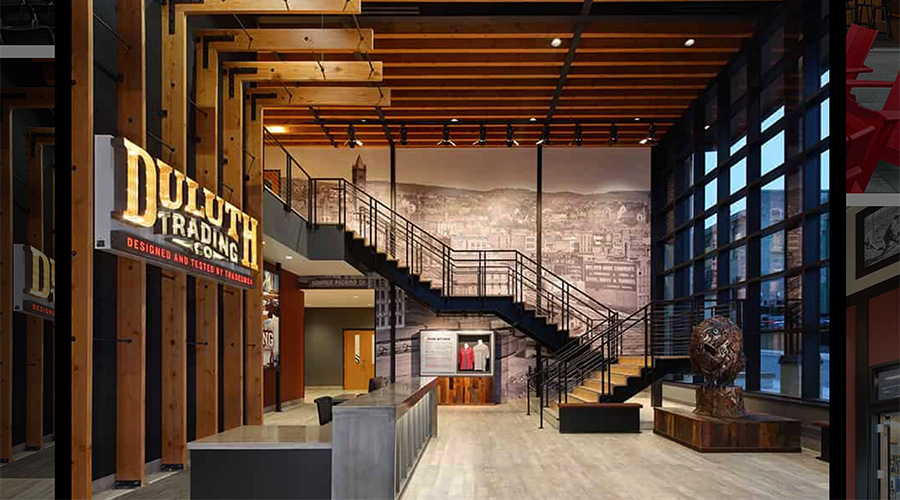Duluth Holdings Inc., the parent of Duluth Trading, reported earnings more than doubled in the second quarter as sales grew 12.6 percent.
Highlights for the Second Quarter Ended August 2, 2020
- Net sales increased 12.6 percent to $137.4 million compared to $122.0 million in the prior-year second quarter;
- Direct-to-consumer net sales increased 66.9 percent and retail store net sales decreased 40.4 percent as stores re-opened throughout the first half of the quarter;
- Gross margin decreased to 52.8 percent compared to 53.1 percent in the prior-year second quarter;
- Operating income increased to $9.8 million compared to operating income of $3.7 million in the prior-year second quarter;
- Net income increased to $5.9 million, or $0.18 per diluted share, compared to net income of $1.9 million, or $0.06 per diluted share, in the prior-year second quarter;
- Adjusted EBITDA increased 75.3 percent to $16.8 million compared to $9.6 million in the prior-year second quarter; and
- As of June 15, 2020, we have re-opened all of our 62 retail stores in some capacity.
Management Commentary
“The real success story of the second quarter is the strength of the Duluth Trading brand and our eCommerce channel. Net sales grew 13 percent to $137 million driven by a 67 percent growth in direct sales year-over-year and more than doubled the first quarter’s strong direct sales growth rate,” said Steve Schlecht, Executive Chairman and CEO of Duluth Trading.
“Our solid second-quarter results can be attributed to several factors. First, our spring and summer product assortments had widespread appeal to both men and women whether staying at home or venturing outdoors. Second, the technology and infrastructure investments that we made well before the pandemic were critical in meeting the sudden shift in consumer shopping trends. Our enhanced website and mobile capabilities allowed us to easily accommodate the surge in demand. Third, our shift to more digital marketing versus traditional media spend generated a 130 percent lift in new buyer growth in our direct channel. Finally, the omnichannel model continued to validate our commitment even in the face of lower store traffic. Our thesis that having a store in a market builds overall brand awareness once again proved out in the second quarter. Direct sales growth in store markets outpaced that of non-store markets by 21 percentage points.”
“As we move into the fall and holiday seasons, we are doing everything in our control to keep the momentum going. I am confident that our team has the talent, agility and conviction to meet the challenges ahead,” concluded Schlecht.
Operating Results for the Second Quarter Ended August 2, 2020
Net sales increased 12.6 percent, to $137.4 million, compared to $122.0 million in the same period a year ago. The increase was attributed to a 66.9 percent increase in direct-to-consumer net sales, partially offset by a 40.4 percent decrease in retail store net sales. The increase in the direct-to-consumer net sales was driven by a shift of existing customers to online, as well as new buyer growth, particularly within our women’s products. Total new buyer growth increased 54.6 percent compared to the same period a year ago. The decrease in retail store net sales was due to the temporary closure of all stores due to the COVID-19 pandemic. Retail store re-openings ranged from the first week in May through the third week in June.
Net sales in non-store markets increased $17.3 million, or 58.6 percent primarily due to an increase in digital advertising to promote Mother’s Day, Father’s Day and online warehouse clearance events. Net sales in store markets decreased $1.6 million, or 1.8 percent, due to temporary store closures, partially mitigated by a 79.8 percent increase in direct-to-consumer sales in store markets. We believe the difference in the increase in website and catalog sales between store and non-store markets continues to demonstrate the importance of our retail stores in building brand awareness and expanding our loyal customer base.
Men’s business net sales increased 15.3 percent driven by growth in men’s underwear, Alaskan Hardgear and apparel newness. Women’s business net sales increased 9.6 percent driven by the summer solved collection, comfortable basics and plus line apparel.
Gross profit increased 11.8 percent, to $72.5 million, or 52.8 percent of net sales, compared to $64.8 million, or 53.1 percent of net sales, in the corresponding prior-year period. The decrease in gross margin rate was primarily driven by promotional, clearance and sitewide sales events to continue moving inventory during the period of slower store traffic and uncertainty in customer demand. The decrease was partially offset by reduced store delivery costs from lower store sales volumes as well as favorable retail physical inventory count results as compared to the same period a year ago.
Selling, general and administrative expenses increased 2.6 percent to $62.7 million, compared to $61.1 million in the same period a year ago. As a percentage of net sales, selling, general and administrative expenses decreased to 45.6 percent, compared to 50.1 percent in the corresponding prior-year period. The positive leverage was primarily due to shifting to a more efficient digital marketing approach as customer purchasing patterns migrated to online.
The increase in selling, general and administrative expenses were due to increased shipping costs to support website sales, higher retail overhead costs driven by new store growth and increased depreciation expenses associated with investments in technology, partially offset by reduced catalog spend and national TV advertising.
Balance Sheet and Liquidity
The company ended the quarter with a cash balance of $19.0 million, an inventory balance of $167.6 million, net working capital of $117.7 million, $49.5 million outstanding on its $70.5 million term loan, and $30.0 million outstanding on its $80.0 million revolving line of credit.
Fiscal 2020 Outlook
Given the unpredictability of the effects of COVID-19 on, among other things, consumer behavior, store traffic, store operations, production capabilities, timing of deliveries, its employees, economic activity, and the market generally in the coming weeks and months, the company is unable to provide specific earnings guidance at this time.
In response to expected impacts to sales plans, the company has reduced its planned capital spend levels from the beginning of the fiscal year by 50 percent to approximately $15 million primarily by decreasing fiscal 2020 new store openings to four and deferring certain technology and infrastructure projects, as well as continuing to focus on managing expense, extending payment terms and adjusting inventory receipt plans.
Photo courtesy Duluth Trading
















